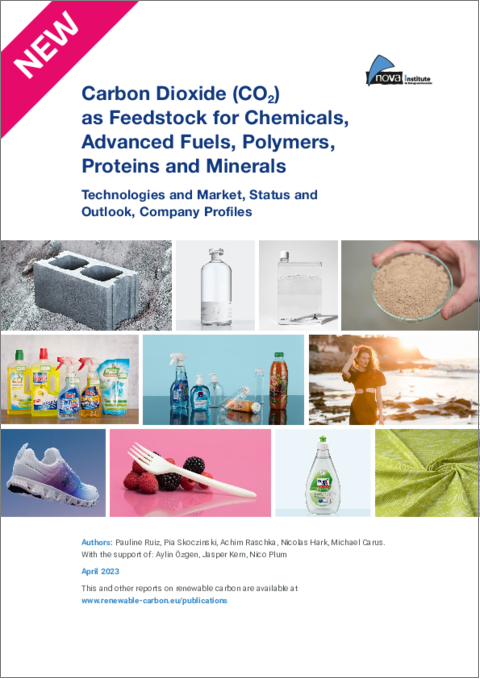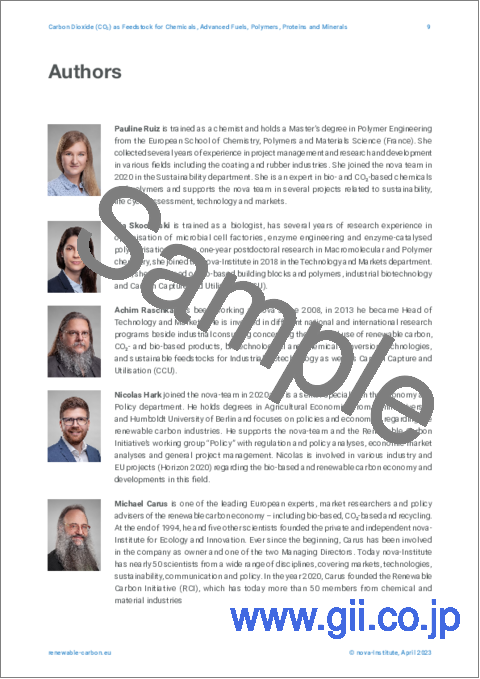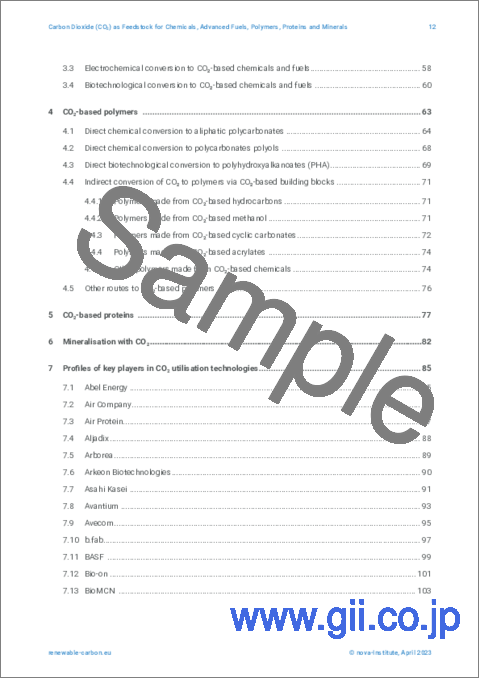|
|
市場調査レポート
商品コード
1267419
化学品、先進燃料、ポリマー、タンパク質、鉱物の原料としての二酸化炭素(CO2):技術と市場、現状と展望、企業プロファイルCarbon Dioxide (CO2) as Feedstock for Chemicals, Advanced Fuels, Polymers, Proteins and Minerals: Technologies and Market, Status and Outlook, Company Profiles |
||||||
| 化学品、先進燃料、ポリマー、タンパク質、鉱物の原料としての二酸化炭素(CO2):技術と市場、現状と展望、企業プロファイル |
|
出版日: 2023年04月30日
発行: Nova-Institut GmbH
ページ情報: 英文 242 Pages
納期: 即納可能
|
- 全表示
- 概要
- 図表
- 目次
当レポートでは、化学品、先進燃料、ポリマー、タンパク質、鉱物の原料としての二酸化炭素(CO2)に焦点を当て、それぞれの概要と将来的見通し、および市場に参入する主要企業の詳細なプロファイルなどをまとめています。
目次
第1章 エグゼクティブサマリー
第2章 イントロダクション
- 炭素の回収と利用(CCU)とは
- CCU、CCS(二酸化炭素の回収と隔離)、およびCDR(二酸化炭素の除去)
- 回収された炭素の利用はどの程度持続可能か
- CCU政策概要
- 炭素回収
- 再生可能エネルギーと水素の生産
- CO2利用の触媒作用
- CO2ベースの製品の現在および将来の商業的利用可能性
第3章 CO2ベースの化学品と燃料
- CO2の従来の化学変換
- CO2の直接利用
- 尿素
- サリチル酸
- エチレンカーボネートおよびプロピレンカーボネート
- CO2ベースの化学品および燃料への化学変換
- 一酸化炭素と合成ガス
- メタン
- メタノール
- フィッシャー・トロプシュ炭化水素
- その他の環状炭酸エステル
- アクリレート
- CO2ベースの化学品および燃料への電気化学的変換
- CO2ベースの化学品と燃料へのバイオテクノロジー変換
第4章 CO2ベースのポリマー
- 脂肪族ポリカーボネートへの直接化学変換
- ポリカーボネートポリオールへの直接化学変換
- ポリヒドロキシアルカノエート(PHA)へのバイオテクノロジーによる直接変換
- CO2ベースのビルディングブロックによるCO2のポリマーへの間接変換
- CO2ベースのポリマーへのその他のルート
第5章 CO2ベースのタンパク質
第6章 CO2による鉱化作用
第7章 CO2利用技術の主要参入企業のプロファイル
- Abel Energy
- Air Company
- Air Protein
- Aljadix
- Arborea
- Arkeon Biotechnologies
- Asahi Kasei
- Avantium
- Avecom
- b.fab
- BASF
- Bio-on
- BioMCN
- Blue Planet Systems
- BRAIN
- Braskem
- Breathe Applied Sciences
- bse Methanol
- C4X Technologies
- Calidris Bio
- CarbiCrete
- Carbon8
- Carbonade
- CarbonCure
- CarbonFree
- Carbon one
- Carbon Recycling International
- Cellana
- Cemvita Factory
- CERT Systems
- CO2BioClean
- Coval Energy
- Covestro
- Dalian Institute of Chemical Physics
- Deep Branch Biotechnology
- Denka Company
- Dimensional Energy
- Dioxide Materials
- Dow
- Econic Technologies
- EEW
- Electrochaea
- Empower Materials
- Evonik Operations (Rheticus project)
- Fairway Methanol
- Fortera
- GreenOre
- greenSand
- Hago Energetics
- HeidelbergCement
- Hitachi Zosen Inova
- Hyundai Motor Group
- INERATEC
- Infinium
- Inner Mongolia Mengxi High-Tech Group
- Jiangsu Zhongke Jinlong-CAS Chemical
- Jilin Boda New Materials
- Johnson Matthey
- Kiverdi
- Krajete
- LanzaTech
- Liquid Wind
- MAN Energy Solutions
- Mango Materials
- Mantra Energy Alternatives
- Methanology
- Mineral Carbonation International
- Mitsubishi Group
- NatureWorks/Calysta
- Newlight Technologies
- Nordic Electrofuel
- Norner
- Novomer/Danimer
- NovoNutrients
- OCOchem
- Omega Green
- OMV
- Orbix
- P2X Europe
- Perstorp
- Photanol
- Phytonix
- Pond Technologies
- Power to Methanol Antwerp
- Prometheus Fuels
- Renewable Hydrogen Canada
- RenewCO2
- Repsol
- SAF + Consortium
- Saudi Aramco
- SCHAEFER KALK
- SecondCircle
- SeeO2 Energy
- Shell
- Siemens Energy
- SK Innovation
- Skyre
- Solar Foods
- Solidia
- Solmeyea
- Sunfire
- Swiss Liquid Future
- Synhelion
- Synkero
- Taizhou Bangfeng Plastic
- Thyssenkrupp
- Tianguan Group
- TNO (VoltaChem)
- Topsoe
- Twelve
- Uniper
- University of Tubingen
- ViridiCO2
- VITO
- VTT Technical Research Centre of Finland
- Wartsila
頭字語のリスト
参考文献
List of Figures
- Figure 1: Carbon Dioxide Utilisation and Renewable Energy
- Figure 2: Ways to Use CO2 for Chemicals and Polymers
- Figure 3: Renewable Energy and Renewable Carbon for a Sustainable Future
- Figure 4: Carbon Dioxide Utilisation and Renewable Energy
- Figure 5: Metalloporphyrin complexes for PPC synthesis (Grignard et al. 2019)
- Figure 6: Structure of triethyl borane, a possible organocatalyst for CO2-based polycarbonates (Huang et al. 2020)
- Figure 7: Global Carbon demand for Chemicals and Materials
- Figure 8: Ways to Use CO2 for Chemicals and Polymers
- Figure 9: Kolbe-Schmitt process to salicylic acid
- Figure 10: Synthesis of propylene carbonate from CO2 and propylene oxide
- Figure 11: Synthesis of glycerol carbonate from CO2 and glycerol (Christy et al. 2018)
- Figure 12: Potential direct and indirect uses of glycerol carbonate (Sonnati et al. 2013)
- Figure 13: Ways to Use CO2 for Polymers
- Figure 14: Direct chemical reaction for CO2-based linear aliphatic polycarbonates
- Figure 15: Direct chemical reaction for CO2-based cyclo-aliphatic polycarbonates
- Figure 16: Copolymerisation of limonene oxide with CO2 (Hauenstein et al. 2016)
- Figure 17: Synthesis of polyurethane based on Cardyon® (Covestro, 2019)
- Figure 18: Comparison between sources of carbonyl group for polycarbonate (Asahi Kasei Corp 2017)
- Figure 19: General process overview of gas fermentation for single-cell protein production (adapted from Pander et al. (2020))
- Figure 20: Illustration of single-cell production with hydrogen oxidising bacteria (adapted from Marcellin et al. (2022))
- Figure 21: Illustration of single-cell production with acetogenic bacteria (adapted from (Marcellin et al. 2022))
List of Tables
- Table 1: CO2-based products: 2022 production capacity and 2030 outlook
- Table 2: Energy demand (heat and electricity) of various types of CO2-capture, reported by different sources (Kähler et al., 2022)
- Table 3: Overview of different C and CO2 sources, the CO2 concentration contained in the exhaust gas and the CO2 capture costs for the respective point source
- Table 4: Typical carbon concentration in steel plant exhaust gases
- Table 5: Capture methods and technologies.
- Table 6: Selection of companies active in carbon capture technologies
- Table 7: Overview of different electrolysis technologies
- Table 8: Selection of companies and projects active in green hydrogen production
- Table 9: CO2-based products: 2022 production capacity and 2030 outlooks
- Table 10: Companies developing and commercialising CO2-based ethylene and propylene carbonate
- Table 11: Companies developing and commercialising CO2-based CO or syngas via chemical conversion (rWGS)
- Table 12: Companies developing and commercialising CO2-based methane from CO2 hydrogenation
- Table 13: Companies developing and commercialising CO2-based methanol based on CO2 hydrogenation
- Table 14: Companies developing and commercialising CO2-based hydrocarbon based on Fischer- Tropsch synthesis
- Table 15: Companies developing and commercialising CO2-based cyclic carbonate esters
- Table 16: Companies developing CO2-based acrylates
- Table 17: Companies working on electrochemical reduction of CO2 for the production of various chemicals
- Table 18: Photosynthetic and non-photosynthetic microorganisms
- Table 19: Companies working on biotechnological conversion of CO2 for the production of various chemicals
- Table 20: Companies developing and commercialising CO2-based aliphatic polycarbonates (as thermoplastic)
- Table 21: Companies developing and commercialising CO2-based polycarbonate polyols
- Table 22: Companies developing and commercialising CO2-based polyhydroxyalkanoates
- Table 23: Companies and projects with a proven current focus on polymers made from CO2-based hydrocarbon
- Table 24: Companies and projects with a proven current focus on polymers made from CO2-based methanol
- Table 25: Companies and projects with a proven current focus on polycarbonate made from CO2-based diphenyl carbonate
- Table 26: Companies and projects with a proven current focus on polymers made from CO2-based acrylate derivatives
- Table 27: Companies and projects with a proven current focus on polymers made from CO2-based chemicals, usually made via biotechnological or electrochemical conversion
- Table 28: Microorganisms for single cell proteins
- Table 29: Companies active in biotechnological conversion of CO2 to proteins
- Table 30: Companies active in mineralisation of CO2
New report on the use of CO2 for chemicals, advanced fuels, polymers, proteins and minerals by nova-Institute - A deep and comprehensive insight into the evolving technologies, trends and the dynamically growing market of CO2 transformation and utilisation.
Several successfully implemented technologies are now in commercial use, and many more are at the laboratory and pilot stage. A current total production capacity of novel CO2-based products of about 1.3 Mt/a in 2022 is observed. The production capacity in 2022 is dominated by the production of CO2-based aromatic polycarbonates, ethanol from captured CO/CO2, aliphatic polycarbonate and methanol. By 2030, the capacity outlook for CO2-based products is expected to exceed 6 Mt/a of CO2-based products. High dynamic growth is observed for methanol projects, methane plants, ethanol and hydrocarbons - the latter especially for the aviation sector. The potential of CCU has been recognised by several global brands which are already expanding their feedstock portfolio. However, in Europe, investments and prospects for CO2 utilisation are largely undermined by a lack of political support. In contrast, we see supportive policies in China as well as in the US with the Inflation Reduction Act. Such smart policies are needed to bridge the gap between now and 2050 for companies to remain competitive in the sustainable transformation.
nova-Institute's new report examines this renewable carbon source in detail:
- Which products can be made from CO2, and by which processes?
- To which extend have the technologies already been developed and implemented in pilot, demonstration and commercial plants?
- Which companies are working on technologies to uses CO2 as a feedstock?
- What are the trends in CO2 utilisation in the coming years?
This report addresses the fuel, chemical and materials industries, brands, technology scouts, investors, and policy makers. The report provides 240 pages of information on CO2 utilisation. All the 116 companies mentioned are described in detailed profiles.
Table of Contents
1. Executive summary
2. Introduction
- 2.1. What is Carbon Capture & Utilisation (CCU)?
- 2.2. CCU, CCS (Carbon Capture & Sequestration) and CDR (Carbon Dioxide Removal)
- 2.3. How sustainable is the utilisation of captured carbon?
- 2.4. Policy overview for CCU
- 2.5. Carbon capture
- 2.5.1. Carbon capture technologies and methods
- 2.5.2. Selection of carbon capture companies and projects
- 2.6. Renewable energy and production of hydrogen
- 2.6.1. Green hydrogen production
- 2.6.2. Selection of green hydrogen companies and projects
- 2.7. Catalysis for CO2 utilisation
- 2.8. Current and future commercial availability of CO2-based products
3. CO2-based chemicals and fuels
- 3.1. Conventional chemical conversion of CO2
- 3.1.1. Direct use of CO2
- 3.1.2. Urea
- 3.1.3. Salicylic acid
- 3.1.4. Ethylene carbonate and propylene carbonate
- 3.2. Chemical conversion to CO2-based chemicals and fuels
- 3.2.1. Carbon monoxide and syngas
- 3.2.2. Methane
- 3.2.3. Methanol
- 3.2.4. Fisher-Tropsch hydrocarbons
- 3.2.5. Other cyclic carbonate esters
- 3.2.6. Acrylates
- 3.3. Electrochemical conversion to CO2-based chemicals and fuels
- 3.4. Biotechnological conversion to CO2-based chemicals and fuels
4. CO2-based polymers
- 4.1. Direct chemical conversion to aliphatic polycarbonates
- 4.2. Direct chemical conversion to polycarbonates polyols
- 4.3. Direct biotechnological conversion to polyhydroxyalkanoates (PHA)
- 4.4. Indirect conversion of CO2 to polymers via CO2-based building blocks
- 4.4.1. Polymers made from CO2-based hydrocarbons
- 4.4.2. Polymers made from CO2-based methanol
- 4.4.3. Polymers made from CO2-based cyclic carbonates
- 4.4.4. Polymers made from CO2-based acrylates
- 4.4.5. Other polymers made from CO2-based chemicals
- 4.5. Other routes to CO2-based polymers
5. CO2-based proteins
6. Mineralisation with CO2
7. Profiles of key players in CO2 utilisation technologies
- 7.1. Abel Energy
- 7.2. Air Company
- 7.3. Air Protein
- 7.4. Aljadix
- 7.5. Arborea
- 7.6. Arkeon Biotechnologies
- 7.7. Asahi Kasei
- 7.8. Avantium
- 7.9. Avecom
- 7.10. b.fab
- 7.11. BASF
- 7.12. Bio-on
- 7.13. BioMCN
- 7.14. Blue Planet Systems
- 7.15. BRAIN
- 7.16. Braskem
- 7.17. Breathe Applied Sciences
- 7.18. bse Methanol
- 7.19. C4X Technologies
- 7.20. Calidris Bio
- 7.21. CarbiCrete
- 7.22. Carbon8
- 7.23. Carbonade
- 7.24. CarbonCure
- 7.25. CarbonFree
- 7.26. Carbon one
- 7.27. Carbon Recycling International
- 7.28. Cellana
- 7.29. Cemvita Factory
- 7.30. CERT Systems
- 7.31. CO2BioClean
- 7.32. Coval Energy
- 7.33. Covestro
- 7.34. Dalian Institute of Chemical Physics
- 7.35. Deep Branch Biotechnology
- 7.36. Denka Company
- 7.37. Dimensional Energy
- 7.38. Dioxide Materials
- 7.39. Dow
- 7.40. Econic Technologies
- 7.41. EEW
- 7.42. Electrochaea
- 7.43. Empower Materials
- 7.44. Evonik Operations (Rheticus project)
- 7.45. Fairway Methanol
- 7.46. Fortera
- 7.47. GreenOre
- 7.48. greenSand
- 7.49. Hago Energetics
- 7.50. HeidelbergCement
- 7.51. Hitachi Zosen Inova
- 7.52. Hyundai Motor Group
- 7.53. INERATEC
- 7.54. Infinium
- 7.55. Inner Mongolia Mengxi High-Tech Group
- 7.56. Jiangsu Zhongke Jinlong-CAS Chemical
- 7.57. Jilin Boda New Materials
- 7.58. Johnson Matthey
- 7.59. Kiverdi
- 7.60. Krajete
- 7.61. LanzaTech
- 7.62. Liquid Wind
- 7.63. MAN Energy Solutions
- 7.64. Mango Materials
- 7.65. Mantra Energy Alternatives
- 7.66. Methanology
- 7.67. Mineral Carbonation International
- 7.68. Mitsubishi Group
- 7.69. NatureWorks/Calysta
- 7.70. Newlight Technologies
- 7.71. Nordic Electrofuel
- 7.72. Norner
- 7.73. Novomer/Danimer
- 7.74. NovoNutrients
- 7.75. OCOchem
- 7.76. Omega Green
- 7.77. OMV
- 7.78. Orbix
- 7.79. P2X Europe
- 7.80. Perstorp
- 7.81. Photanol
- 7.82. Phytonix
- 7.83. Pond Technologies
- 7.84. Power to Methanol Antwerp
- 7.85. Prometheus Fuels
- 7.86. Renewable Hydrogen Canada
- 7.87. RenewCO2
- 7.88. Repsol
- 7.89. SAF + Consortium
- 7.90. Saudi Aramco
- 7.91. SCHAEFER KALK
- 7.92. SecondCircle
- 7.93. SeeO2 Energy
- 7.94. Shell
- 7.95. Siemens Energy
- 7.96. SK Innovation
- 7.97. Skyre
- 7.98. Solar Foods
- 7.99. Solidia
- 7.100. Solmeyea
- 7.101. Sunfire
- 7.102. Swiss Liquid Future
- 7.103. Synhelion
- 7.104. Synkero
- 7.105. Taizhou Bangfeng Plastic
- 7.106. Thyssenkrupp
- 7.107. Tianguan Group
- 7.108. TNO (VoltaChem)
- 7.109. Topsoe
- 7.110. Twelve
- 7.111. Uniper
- 7.112. University of Tübingen
- 7.113. ViridiCO2
- 7.114. VITO
- 7.115. VTT Technical Research Centre of Finland
- 7.116. Wärtsilä




